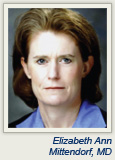Chemotherapy can be delivered before breast-conserving therapy or after surgery, without influencing long-term local-regional recurrence, a large study from The University of Texas MD Anderson Cancer Center confirmed. The data were presented at the 2011 Breast Cancer Symposium in San Francisco.1
 “A woman can have chemotherapy or surgery first, and the choice will not affect her outcome,” said Elizabeth Ann Mittendorf, MD, a surgical oncologist at MD Anderson.
“A woman can have chemotherapy or surgery first, and the choice will not affect her outcome,” said Elizabeth Ann Mittendorf, MD, a surgical oncologist at MD Anderson.
The findings suggest that treatment success is due more to biologic factors than chemotherapy timing, she said. “The molecular characteristics of the tumor and other factors have an impact on treatment success, but not the order in which chemotherapy and surgery are given.”
The retrospective study included 2,984 women treated between 1987 and 2005 with segmental mastectomy and whole-breast irradiation, including 78% who underwent surgery before chemotherapy and 22% who had neoadjuvant chemotherapy, then surgery. Women with worse prognostic factors were more likely to have preoperative chemotherapy.
Approaches Have Similar Outcomes
The 5- and 10-year local-regional recurrence-free survival rates were excellent for both groups: 97% and 94%, respectively, for those who had surgery first, and 93% and 90%, respectively, for those who had neoadjuvant chemotherapy. When patients were evaluated by presenting clinical stage, there were no differences with respect to local-regional recurrence-free survival rates. Even in patients who had one or more adverse features, such as later disease stage and higher tumor grade or estrogen receptor–negative status, no survival differences emerged when a number of adverse features were controlled for.
Neoadjuvant chemotherapy resulted in complete pathologic responses in 20% of patients, and allowed for cancer stage to be downgraded in almost half the patients with stage II or III disease. Neoadjuvant chemotherapy, therefore, made breast-conserving therapy (vs mastectomy) more likely among clinical stage II and III patients. Breast-conserving therapy was performed in 69% of stage II patients who underwent neoadjuvant chemotherapy compared with 19% who had surgery first, and in 24% and 1%, respectively, of stage III patients (P < .001).
“Even women who present with clinical stage II or III disease may have good results with [breast-conserving therapy] after chemotherapy and not need a mastectomy,” Dr. Mittendorf said.
The group plans to extend the study to include MD Anderson patients treated after 2005. “Since 2005, treatment techniques have improved, including the ability to add targeted therapies to chemotherapy,” she said. “In the future we will look at the effects of newer agents, and we anticipate the results will be even more favorable for women who received these treatments before surgery.”
‘Apples and Oranges’
But Barbara Fowble, MD, of the University of California School of Medicine, San Francisco, the invited discussant of the abstract, expressed concern about the imbalance in patient numbers between the arms, making this a comparison of “apples and oranges,” she told The ASCO Post.
Among stage III patients, 157 underwent neoadjuvant chemotherapy, while just 18 had surgery first. Among stage I patients, 45 had neoadjuvant chemotherapy and 1,854 had surgery first. “So the only things we can really say from the data pertain to the stage II patients, who had about 450 patients per arm,” she suggested.
Essentially, she added, the study supports what has already been established by randomized controlled trials: that the two approaches provide comparable outcomes in appropriately selected patients. ■
Disclosure: Drs. Mittendorf and Fowble reported no potential conflicts of interest.
Reference
1. Mittendorf EA, Buchholz TA, Tucker SL, et al: Impact of chemotherapy timing on local-regional failures in patients with breast cancer undergoing breast-conserving therapy. 2011 Breast Cancer Symposium. Abstract 82. Presented September 8, 2011.

